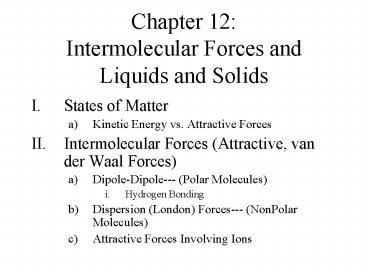Chapter 12: Intermolecular Forces and Liquids and Solids - PowerPoint PPT Presentation
1 / 41
Title:
Chapter 12: Intermolecular Forces and Liquids and Solids
Description:
Nonmetal Atom. 2 or more nonmetals. Covalent. Intermolecular Force. Molecule. 2 or more nonmetals. Molecular. Electrostatic Attraction. Ion & - ions. Ionic ... – PowerPoint PPT presentation
Number of Views:286
Avg rating:3.0/5.0
Title: Chapter 12: Intermolecular Forces and Liquids and Solids
1
Chapter 12Intermolecular Forces and Liquids and
Solids
- States of Matter
- Kinetic Energy vs. Attractive Forces
- Intermolecular Forces (Attractive, van der Waal
Forces) - Dipole-Dipole--- (Polar Molecules)
- Hydrogen Bonding
- Dispersion (London) Forces--- (NonPolar
Molecules) - Attractive Forces Involving Ions
2
Intermolecular Forces and Liquids and Solids
- Properties of Liquids
- Viscosity
- Meniscus Formation
- Surface Tension
- Capillary Action
- Phase Changes
- Equilibrium Vapor Pressure
- Normal boiling point
- Phase Diagrams
3
Intermolecular Forces and Liquids and Solids
- Crystalline Structure of Solids
- Unit Cells (Simple Cubic, BCC, FCC)
- Coordination Number
- Lattice Points in a Unit Cell
- Radius vs. Unit Cell Edge Length,a
- Density
- Types of Crystalline Solids
- Ionic, Molecular, Covalent, and Metallic
4
Properties of Liquids
- Part III
5
Properties of Liquid
- Viscosity Resistance to Flow
- Increase Intermolecular Force Increase Viscosity
- Increase Temperature Decrease Intermolecular
Force Decrease Viscosity
6
Properties of Liquids
Cohesion is the intermolecular attraction between
like molecules
Adhesion is an attraction between unlike molecules
11.3
7
Concave Meniscus of Water
Chemistry The Science in Context by Thomas R
Gilbert, Rein V. Kirss, and Geoffrey Davies,
Norton Publisher, 2004, p 458
8
- Surface Tension
- Attraction of surface
- molecules that cause the liquid
- surface to contract and become
- more spherical
- 2.Amount of energy required to
- stretch or increase the surface
9
Consequences of Surface Tension
Chemistry The Science in Context by Thomas R
Gilbert, Rein V. Kirss, and Geoffrey Davies,
Norton Publisher, 2004, p 457
10
Consequences of Surface Tension
Chemistry The Science in Context by Thomas R
Gilbert, Rein V. Kirss, and Geoffrey Davies,
Norton Publisher, 2004, p 458
11
CapillaryAction Rise of Liquid up a Very Small
Diameter Glass Tube
Chemistry The Science in Context by Thomas R
Gilbert, Rein V. Kirss, and Geoffrey Davies,
Norton Publisher, 2004, p 459
12
Increasing Strength of Intermolecular Force
- Higher Boiling and Melting Point
- Higher Surface Tension
- Higher Viscosity
- Lower Equilibrium Vapor Pressure
13
Phase Changes
- Part IV
14
Equilibrium Vapor Pressure
- Pressure exerted by gas vapor, in closed
container, at a given temperature.
15
(No Transcript)
16
Before Evaporation
At Equilibrium
11.8
17
(No Transcript)
18
Why is the Boiling Point of Water Constant ?
Heat
19
Phase Diagram
Increasing Pressure
Solid
Liquid
Increasing Temperature
Gas
Triple Point
20
Solid
Liquid
Gas
21
Phase Diagram of Water
Liquid
Solid
Gas
22
Properties of Crystalline Solids
- Part V
23
(No Transcript)
24
(No Transcript)
25
Unit Cells
26
(No Transcript)
27
Simple Cubic Unit Cell
28
Coordination
- of Lattice Points Surrounding Each Lattice
Point
29
(No Transcript)
30
Simple Cubic Unit Cells
31
(No Transcript)
32
(No Transcript)
33
(No Transcript)
34
Crystalline Solids Differ in
- Lattice Point Representation
- Type of Force Holding Lattice Point Together
35
Crystalline Solids
36
Ionic Crystals
CsCl
ZnS
CaF2
37
Molecular Crystals (Ice)
38
Covalent Crystals
Graphite
Diamond
39
Metallic Crystals
40
Properties of Crystalline Solids
41
Crystalline Solids
42
(No Transcript)































